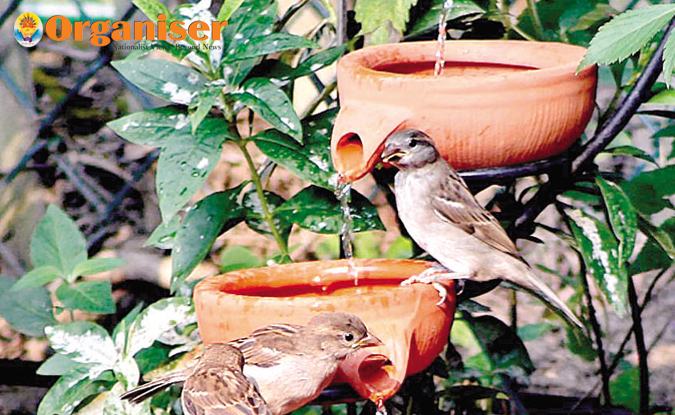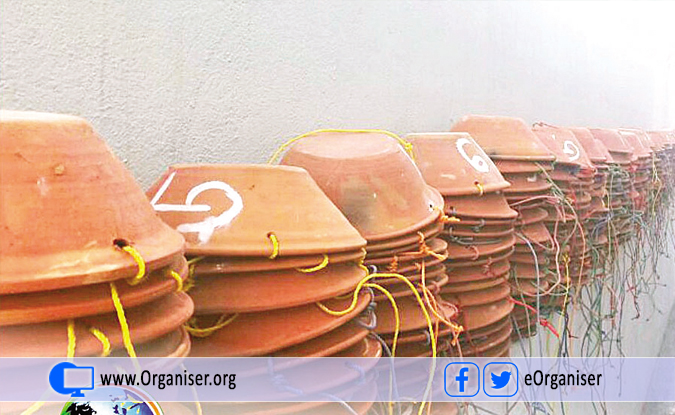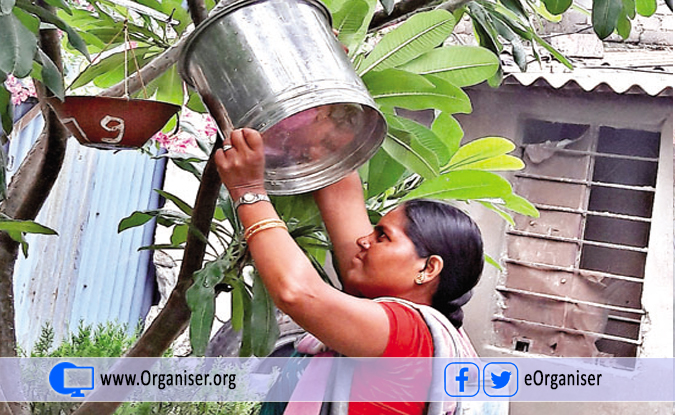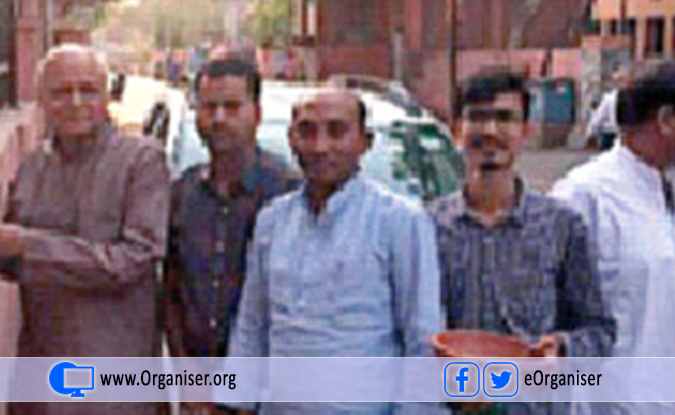RSS Swayamsevaks save millions of birds in Rajasthan by installing ‘Parindas’ at over 40,000 places to offer water to the birds which used to fall on the ground after getting unconscious for want of water
Shyam Rathore is an IT engineer in Bhilwara, Rajasthan. The task he never misses every day is offering water to the birds through a ‘Parinda’ (water pot) that he installed outside his house. “The extreme satisfaction that I get after offering water to a thirsty person who knocks at my door in the scorching summer, the same emotion generates in my heart after offering water to the birds in the ‘Parinda’. When any bird sits on it and quenches its thirst, I feel God has accepted the water offered by me,” he says. Readymade garment trader Amit Pokharna in the same city is so much dedicated to this cause that he has distributed 20,000 ‘Parindas’ and ensured their instalation in the last two years.

Udaipur-based biodiversity expert SP Mehra finds more satisfaction in offering water to the birds than distributing fruits to the patients in hospitals or donating blankets to the people living on footpath in winters. “It is service to the voiceless creatures,” he says. For Ashok Sharma who runs a school in Jaipur, offering water to the birds is serving God in living form. “Water is life. The human beings get it anyway, but the birds can do nothing when they get thirsty. If we offer them water, it is serving God in the living form,” he says.
Shyam Rathore, Amit Pokharna, SP Mehra and Ashok Sharma are among thousands of people in Rajasthan who are part of a campaign to save the birds from heatstroke in summers. The impact of the drive can be understood from the fact that the number of birds falling on the ground after getting unconscious has substantially decreased in the areas where the people have installed pots outside their houses, in gardens or on the trees in their premises to offer them water. “When I see any bird falling on the ground after getting unconscious for want of water, my heart bleeds. I am thankful to ‘Apna Sansthan’ as it is stirring the people to install more Parindas outside their houses,” says Om Kasara, a resident of Bhilwara.
Essential for Food Cycle
Installing ‘Parindas’ is not a new tradition, it has been part of our daily samskars since the ancient time. But now, the new generation, disconnected from its roots in the name of modernity, has stopped following it. But Rajasthan based Amritadevi Paryavaran Nagrik Sansthan (Apna Sansthan) started efforts to revive this tradition on January 3, 2016. The movement has gained momentum to the extent that the installation of ‘Parindas’ is now done through organised public programme. Hundreds of people gather at a place with their respective ‘Parindas’ and install them outside their houses or in gardens after the event. Those people themselves take care of them throughout the year. This year about 30,000 ‘Parindas’ were installed in Bhilwara, Jaipur, Sikar, Churu, Jhunjhunu, Kota and Udaipur. Next year over 50,000 new Parindas will be installed. The prime motivation behind this campaign is RSS swayamsevaks who through ‘Apna Sansthan’ motivate people to save the birds because they feel that if we fail to preserve biodiversity today, our entire food cycle will severely get affected in coming days.

“The temperature is rising all over the world. The sun heat is more chilling and the number of trees too has decreased. In this condition when the birds do not find shelter and water, they get unconscious and die. Till about two decades back the rivers and waterfalls used to be alive throughout the year. But now most of them have vanished and the birds do not get water. Therefore, we have started this campaign to revive the old tradition of installing pots and putting water into them so that the birds continue to have water. Even the birds coming from far-flung areas in search of food can get water. Apart from it we have also planted over five lakh trees in Rajasthan,” says Shri Vinod Mailana, secretary of the ‘Apna Sansthan’.
Protection of biodiversity is required for ensuring a fair balance between the human beings, creatures and nature. Those who have some knowledge of agriculture, know that about 15 to 18 per cent production in our crops occurs through insect pollination. Nearly half of the output in horticulture occurs through insect pollination, whereas it is 100 per cent in the plants like almond. Insects like honeybees, butterflies, etc. play a key role in pollination. Some bees cannot fly more than half a km. Hence, they need pollen in that radius only every day and in every season. If there are diverse trees and plants in that area, they have access to a variety of flowers and fruits and they continue to get pollen. That is why biodiversity is essential for the human life.
Diversity in Plantation
“The are about 1250 species of birds in our country and 175 of them are in danger. There are some birds, which cannot fly more than two-three km. Sometimes, we, unknowlingly, commit silly mistakes—when we start planting saplings, we plant only a particular sapling like Neem up to 50 km. The flowers and fruits on Neem are only for 20 days in a year. The birds, which cannot fly more than a limit, die in a few days only for want of food. That is why the population of fruit-eating birds is now less than 10 per cent. There are about three lakh varieties of flowering plants in nature, which are called angiosperms. Also, there are about 1.5 lakh species of insects. All these insects and flowering plants are complementary to each other. Hence, while planting the saplings, we should ensure that we plant a variety of saplings, particularly the traditional plants, which grow in that particular region. There are some ground-nesting birds. They make their nests on the plants which are low in height. Hence, all types of plants should be planted,” says Dr Bhagwati Prakash Sharma, Vice Chancellor of the Pacific University, Udaipur.

A woman at Sumori Village in Bhilwara putting water into a ‘Parinda’ for the birds
There are some trees and plants, which offer shelter to the insects that protect the crops from harmful insects. These are about 50-60 types of insects. How the insects harm the crops can be understood from an example of ladyfinger plant. Nature has bestowed the ladyfinger plant with the capacity that its crop synthesises the fragrance, which attracts different types of insects. Those insects leave their eggs on the plant. The larva, which comes out of the egg basically harms the crop. There are some crops, which, when infected, generate a chemical fragrance, which attracts the ants and certain creatures from the soil, which kill the insects harming the plants. It is the natural cycle of protecting the crops. It shows that biodiversity in nature is not only for display, but it is also essential for food cycle, food security and health too.
Food Security and Health
It needs no elaboration that if we fail to maintain balance in the nature, provide shelter to the friendly insects, continue to ruin the trees and plants, and the ants and other creatures living in the soil continue to die due to high use of insecticides, we will have to use high quantity of pesticides to protect our crops in coming days. And how harmful are insecticides not only for the human beings but also for all the creatures is well-known. The insecticides poison not only the soil, but also the groundwater. For example, sometime back, there was news that pesticides were found in Coca-Cola. The recipe of Coca-Cola does not include insecticides. The insecticides, which were sprayed in the crops ultimately contaminated with the underground water and when that water was supplied to the Coca-Cola plant through tube wells, even high-tech machines of Coca-Cola could not clean those insecticides.

Dr Bhagwati Prakash Sharma (left) and others installing ‘Parindas’ in Jaipur
“When the rivers and water bodies were alive throughout the year, there was greenery and sufficient water for every creature throughout the year. Since deforestation has now increased, the rivers, which used to flow about 8-9 months in a year, now flow hardly one or two months. Therefore, installation of ‘Parindas’ is required not only in cities and villages but also in the forests. However, some people have started digging pits and installing tanks in the forests for offering water to the wild animals, but that needs to be taken up on a large scale. There is an acute crisis of water in summers in the forests, which forces the wild animals to reach the human habitations in search of water,” says Shri Lalit Sharma, president of Apna Sansthan, which has also done fantastic work of rainwater conservation in Bhilwara reviving the water level from 140 to 15 feet now.
In order to make biodiversity conservation a movement, ‘Apna Sansthan’ organises different activities also involving different sections of the society. It organised a discussion in Jaipur on July 5 where Dr Bhagwati Prakash Sharma said about 20,000 species of the plants are at the verge of extinction. In Jind, Haryana, the Sewa Bharati workers have decided to install at least 1000 makeshift nests for the birds so that they get shelter without hurdle. The villagers in Lapori village under Dudu tehsil of Jaipur have preserved hundreds of varieties of insects, birds and plants during the last 30 years.
Diversity in plantation of saplings is must not only for conservation of the biodiversity, but for our food cycle, food security and health also. For protecting the birds, they have to be ensured home, food and water at the same place where they live. The RSS swayamsevaks in Rajasthan have made a good beginning. This initaitive needs to be emulated at national level.














Comments